H&R Block Bundle
Who Really Controls H&R Block?
Understanding the ownership of a company is key to grasping its strategic direction and future prospects. H&R Block, a titan in the tax preparation industry, presents a fascinating case study in corporate ownership evolution. From its humble beginnings to its current status, the question of who owns H&R Block is more complex than you might think.
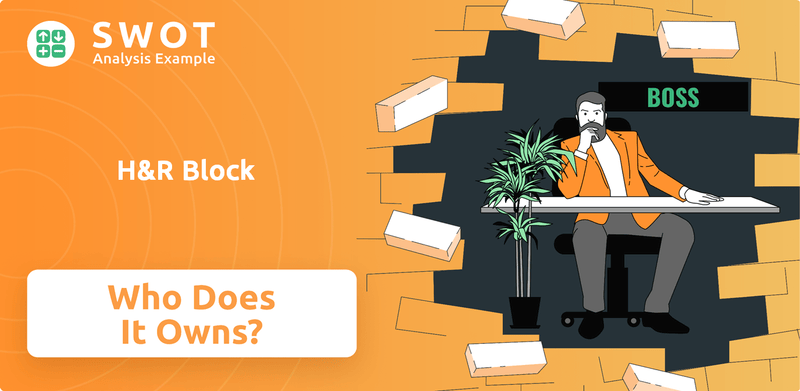
H&R Block's journey began in 1955, transforming from a family-run business to a publicly traded entity through its IPO in 1962. Today, with a revenue of approximately $3.61 billion, the company's ownership structure is crucial for investors and stakeholders alike. Delving into the H&R Block SWOT Analysis can provide additional insights into the company's position in the market, influenced by its ownership and strategic decisions. This exploration will unravel the layers of H&R Block ownership, from its founders to its current shareholders, offering a comprehensive view of this financial services giant.
Who Founded H&R Block?
The story of H&R Block begins with brothers Henry W. Bloch and Richard A. Bloch. They laid the foundation for what would become a tax preparation giant. Their journey started in Kansas City, Missouri, marking the genesis of H&R Block's enduring legacy.
Henry, a World War II veteran with a background in business, initially partnered with his brother Leon in 1946. The focus was on bookkeeping and accounting services. However, the arrival of Richard, with his entrepreneurial spirit, would change the course of their business. His economic studies at the Wharton School of Finance proved to be a valuable asset.
The turning point came when the IRS stopped offering free tax preparation, prompting the brothers to advertise their services. This led to the official establishment of H&R Block, Inc. on January 25, 1955. The name was chosen for its simplicity, avoiding mispronunciations. In its first tax season, the company achieved over $20,000 in gross revenue.
Henry Bloch and his brother Leon started United Business Company in 1946.
The IRS's decision to stop free tax preparation services in 1955 was a pivotal moment.
H&R Block adopted a franchise model early on, selling its New York regional operation in 1956.
Richard Bloch retired in the early 1980s due to health issues.
Henry's son, Thomas M. Bloch, became CEO in 1992, succeeding a founder.
The company was initially funded by a loan, reportedly around $5,000.
While specific details on the initial equity split are not publicly available, the early adoption of a franchise model in 1956 shows a strategic approach to growth. Richard Bloch's departure due to health reasons and the rise of Thomas M. Bloch to CEO marked significant transitions in the company's leadership. To understand more about their strategic growth, you can read about the Growth Strategy of H&R Block. As of 2024, H&R Block continues to be a significant player in the tax preparation industry, serving millions of clients annually. The company's headquarters remain in Kansas City, Missouri.
H&R Block SWOT Analysis
- Complete SWOT Breakdown
- Fully Customizable
- Editable in Excel & Word
- Professional Formatting
- Investor-Ready Format
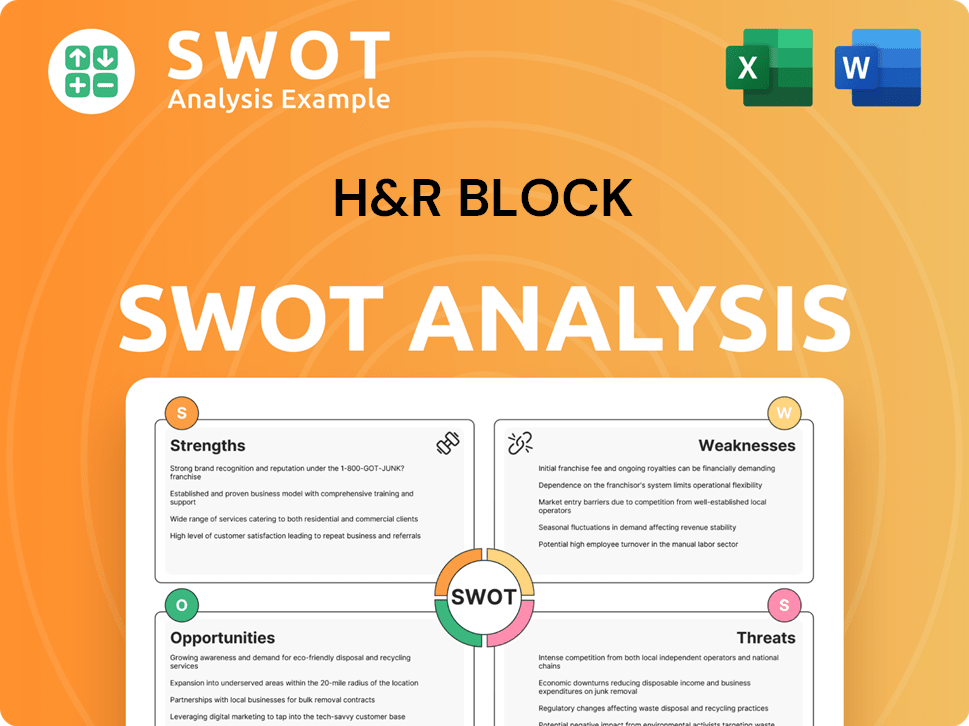
How Has H&R Block’s Ownership Changed Over Time?
The evolution of H&R Block's ownership began in 1962 when it transitioned into a publicly traded company through an Initial Public Offering (IPO), with shares offered at $20. This move provided capital for expansion and diversification. Today, the company's shares are traded on the New York Stock Exchange (NYSE) under the ticker symbol HRB.
H&R Block ownership is primarily distributed among a large number of shareholders, with institutional investors holding a significant majority. As of June 6, 2025, there are 1124 institutional owners and shareholders, collectively holding 161,773,889 shares. Institutional investors held approximately 88% of the company's stock as of late 2024. In May 2025, institutional holdings remained at 95.97%, with mutual funds increasing their holdings from 71.38% to 71.77%.
| Shareholder Type | Percentage of Ownership (approximate, 2025) | Details |
|---|---|---|
| Institutional Investors | ~78.51% | Includes mutual funds, pension funds, and investment advisors |
| Insiders | ~1.24% | Individuals within the company |
| Public Companies and Individual Investors | ~20.24% | Various shareholders |
Throughout its history, H&R Block company has strategically acquired and divested assets, impacting its corporate structure. Notable examples include the 1993 acquisition of MECA Software (TaxCut) to enter the consumer tax software market and the 2019 acquisition of Wave Financial for $405 million (C$537 million) to expand into small business bookkeeping. The company's strategic moves reflect its focus on core competencies and growth areas. To learn more about their strategies, you can read about the Marketing Strategy of H&R Block.
H&R Block ownership is primarily held by institutional investors.
- Major institutional shareholders include BlackRock, Inc., and The Vanguard Group, Inc.
- The company went public in 1962, providing capital for expansion.
- Strategic acquisitions and divestitures have shaped the company's structure.
- Richard C. Breeden is a significant individual shareholder.
H&R Block PESTLE Analysis
- Covers All 6 PESTLE Categories
- No Research Needed – Save Hours of Work
- Built by Experts, Trusted by Consultants
- Instant Download, Ready to Use
- 100% Editable, Fully Customizable
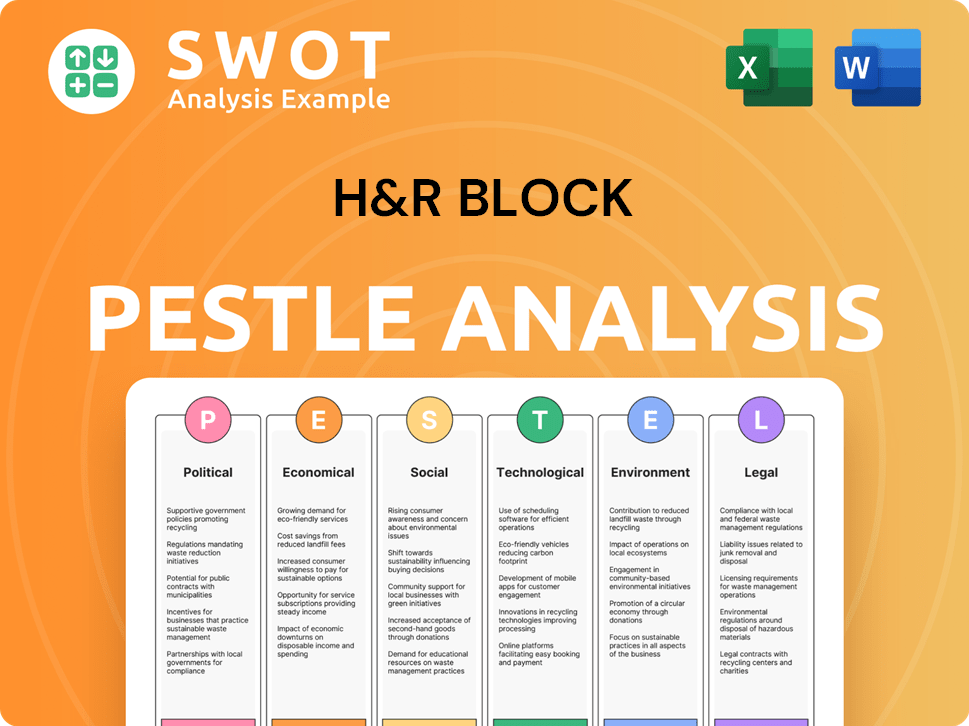
Who Sits on H&R Block’s Board?
The Board of Directors at H&R Block, the H&R Block company, oversees the company's policies and strategies. According to the company's guidelines, the board can have between seven and twelve members. The exact number is decided by a majority vote from the board itself. Currently, the board has nine directors. All of these directors are up for re-election every year.
Shareholders of H&R Block common stock have one vote per share on any matter brought to a vote. There are no cumulative voting rights for electing directors, meaning that a majority of the shares voted can elect all directors. This structure ensures that voting power aligns directly with share ownership. The board advises shareholders on how to vote on various proposals, including the election of directors and executive compensation.
| Director | Title | Since |
|---|---|---|
| Jeffery J. Brown | President and Chief Executive Officer | 2019 |
| Thomas J. Coughlin | Lead Independent Director | 2018 |
| Robert G. Gremillion | Director | 2018 |
| Michelle D. Stacy | Director | 2018 |
| Charles E. Allen | Director | 2020 |
| Karen L. Garrison | Director | 2020 |
| Robert G. Lavery | Director | 2021 |
| Tony J. Weasel | Director | 2021 |
| Gregory T. Johnson | Director | 2023 |
Major institutional investors like BlackRock, FMR LLC, and The Vanguard Group, hold a significant portion of H&R Block ownership, giving them considerable influence through their voting power. As of recent data, insider ownership, which includes shares held by executives and board members, is approximately 1.24%. Richard C. Breeden is the largest individual shareholder, owning 14.46% of the company's shares as of 2025. For certain transactions with shareholders owning 15% or more of outstanding shares, approval from a majority of the issued and outstanding capital stock is required. H&R Block is committed to maintaining integrity and transparency, as highlighted in its fiscal year 2024 Annual ESG Report. Recent SEC filings from February and May 2025 show ongoing reporting requirements related to beneficial ownership and insider transactions. To learn more about the company, you can read this article about H&R Block.
The board of directors at H&R Block oversees the company's strategies and policies.
- Shareholders vote one share per vote.
- Major institutional investors hold significant voting power.
- Insider ownership is around 1.24%.
- Richard C. Breeden is the largest individual shareholder.
H&R Block Business Model Canvas
- Complete 9-Block Business Model Canvas
- Effortlessly Communicate Your Business Strategy
- Investor-Ready BMC Format
- 100% Editable and Customizable
- Clear and Structured Layout
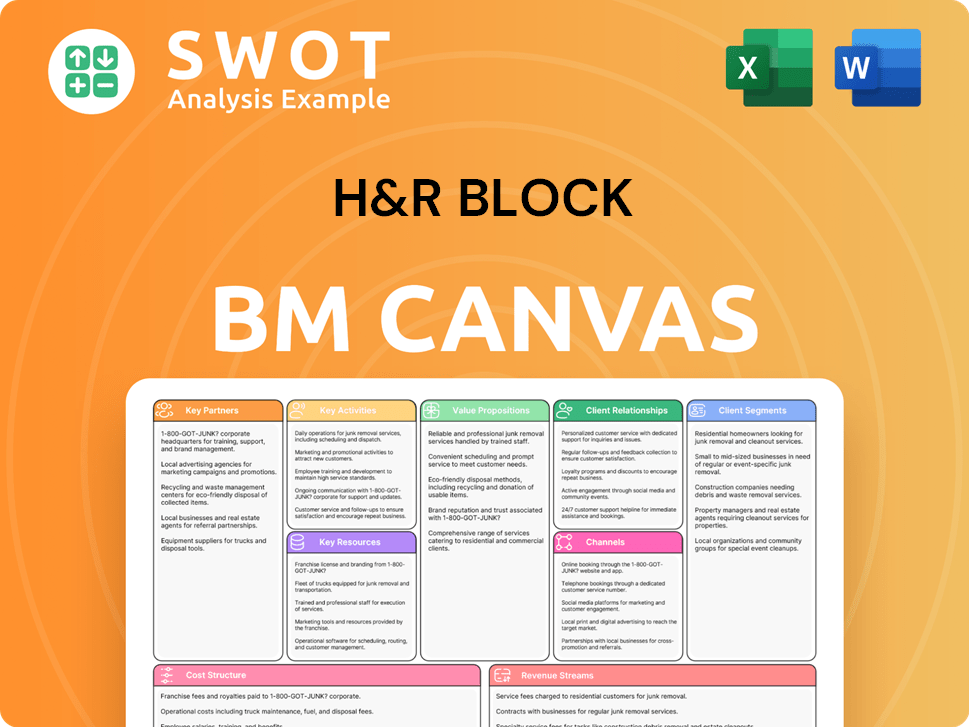
What Recent Changes Have Shaped H&R Block’s Ownership Landscape?
Over the past 3-5 years, focusing on shareholder value has been a key strategy for the H&R Block company. The company has returned more than $4.5 billion to shareholders through dividends and share repurchases since 2016. This has led to the retirement of over 43% of its outstanding shares. In August 2024, the company announced a 17% increase in its quarterly dividend, accompanied by a new share repurchase authorization of $1.5 billion, replacing a prior authorization. The company's commitment to consistent shareholder returns is evident in its over 60 years of consecutive quarterly dividend payments since its 1962 IPO.
Recent ownership trends show a dynamic landscape. While insider selling has been observed in late 2024 and early 2025, institutional and mutual fund holdings have remained relatively stable or increased. For example, in May 2025, institutional investors held steady at 95.97%, and mutual funds increased their holdings from 71.38% to 71.77%. During the same period, insider holdings increased from 0.83% to 0.85%. These movements reflect the evolving H&R Block ownership structure and investor confidence.
| Metric | May 2025 | Change |
|---|---|---|
| Institutional Ownership | 95.97% | Unchanged |
| Mutual Fund Ownership | 71.77% | Increased |
| Insider Ownership | 0.85% | Increased |
The H&R Block company's strategic direction includes expanding beyond traditional tax preparation. Acquisitions such as Wave Financial in 2019 indicate a focus on small business solutions. This move is designed to attract new investor segments. Furthermore, investments in digital innovation and AI are underway to boost efficiency and improve client services. Leadership changes, such as the appointment of Jeff Jones as president and CEO in October 2017 and Richard A. Johnson succeeding Robert A. Gerard as Chairman of the Board, reflect the company's adaptability. The company's fiscal year 2025 outlook projects revenue between $3.69 billion to $3.75 billion and adjusted diluted earnings per share in the range of $5.15 to $5.35. For more information about the company's past, explore a Brief History of H&R Block.
Institutional investors hold a dominant position in H&R Block, with ownership consistently above 95%. Mutual funds also represent a significant portion of the ownership structure, increasing their holdings over time. Insiders, including executives and board members, maintain a smaller but notable stake in the company.
Major investors in H&R Block are primarily institutional investors and mutual funds. These entities play a crucial role in the company's stock performance and strategic direction. The company's ownership structure reflects a blend of institutional and individual investor interests.
H&R Block's leadership has focused on shareholder returns and strategic expansion. Recent appointments and board changes reflect the company's efforts to adapt to market changes. The company's focus on digital innovation and small business solutions is a key part of its growth strategy.
H&R Block's fiscal year 2025 outlook projects revenue between $3.69 billion to $3.75 billion, with adjusted diluted earnings per share in the range of $5.15 to $5.35. The company’s performance is closely watched by investors and analysts. The company's financial health is supported by its focus on client growth.
H&R Block Porter's Five Forces Analysis
- Covers All 5 Competitive Forces in Detail
- Structured for Consultants, Students, and Founders
- 100% Editable in Microsoft Word & Excel
- Instant Digital Download – Use Immediately
- Compatible with Mac & PC – Fully Unlocked
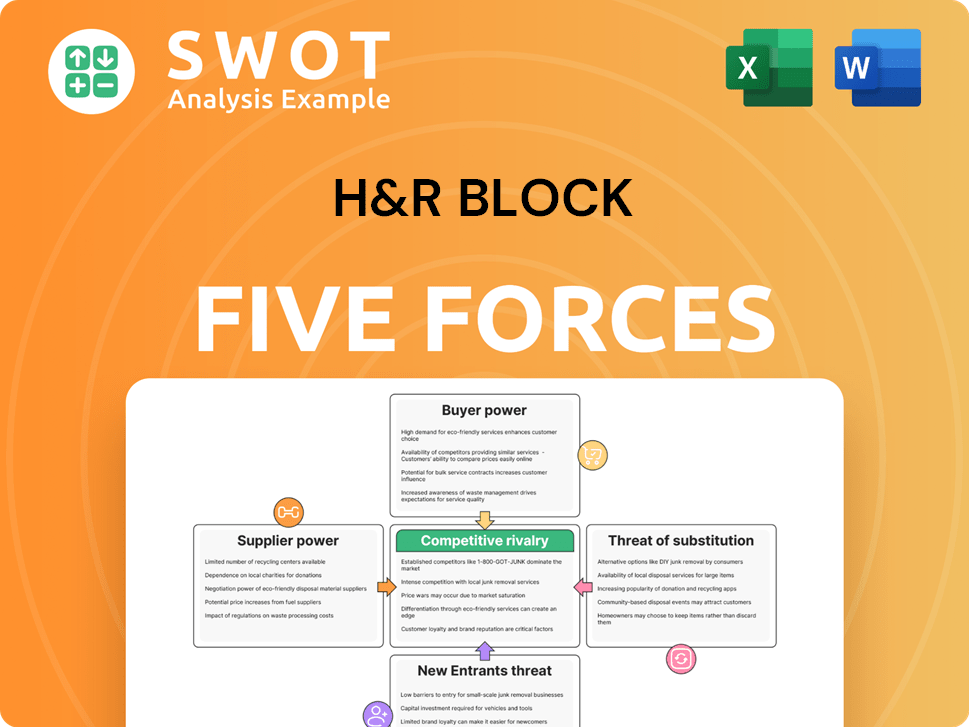
Related Blogs
- What are Mission Vision & Core Values of H&R Block Company?
- What is Competitive Landscape of H&R Block Company?
- What is Growth Strategy and Future Prospects of H&R Block Company?
- How Does H&R Block Company Work?
- What is Sales and Marketing Strategy of H&R Block Company?
- What is Brief History of H&R Block Company?
- What is Customer Demographics and Target Market of H&R Block Company?
Disclaimer
All information, articles, and product details provided on this website are for general informational and educational purposes only. We do not claim any ownership over, nor do we intend to infringe upon, any trademarks, copyrights, logos, brand names, or other intellectual property mentioned or depicted on this site. Such intellectual property remains the property of its respective owners, and any references here are made solely for identification or informational purposes, without implying any affiliation, endorsement, or partnership.
We make no representations or warranties, express or implied, regarding the accuracy, completeness, or suitability of any content or products presented. Nothing on this website should be construed as legal, tax, investment, financial, medical, or other professional advice. In addition, no part of this site—including articles or product references—constitutes a solicitation, recommendation, endorsement, advertisement, or offer to buy or sell any securities, franchises, or other financial instruments, particularly in jurisdictions where such activity would be unlawful.
All content is of a general nature and may not address the specific circumstances of any individual or entity. It is not a substitute for professional advice or services. Any actions you take based on the information provided here are strictly at your own risk. You accept full responsibility for any decisions or outcomes arising from your use of this website and agree to release us from any liability in connection with your use of, or reliance upon, the content or products found herein.